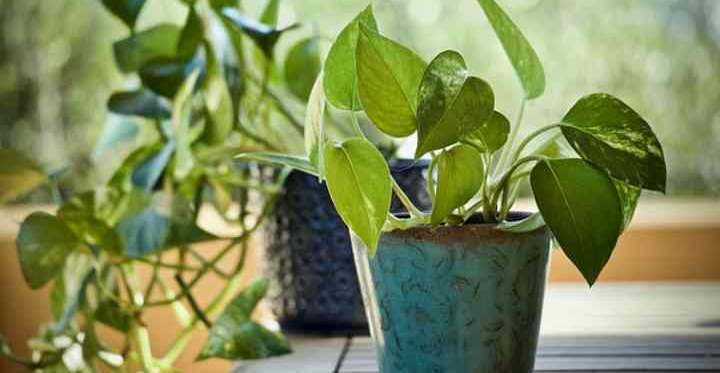Pothos Plant Care: How to Grow Pothos (Epipremnum Aureum, Devil’s Ivy)

Pothos (Epipremnum aureum) is a delightful houseplant that is extremely easy to care for and brings life to any indoor space. Pothos plants are identified by their long trailing stems and brightly-colored green heart-shaped leaves. These vining indoor plants can grow in low light conditions and only need occasional watering. Many popular types of pothos have variegated leaves with colors such as golden-yellow, creamy-white, light green, jade, neon and marble.
How to care for pothos plants: For pothos to thrive indoors, place the plant in bright, indirect sunlight, grow in a well-draining potting mix, and water when the soil is partly dry. Keep humidity levels high and in temperatures between 65°F and 75°F (18°C – 23°C). Fertilize monthly and prune every so often to encourage bushy growth.
Pothos is also called devil’s ivy, taro vine, marble queen, ivy arum, or money plant. Growing pothos indoors can help improve air quality as it’s on the list of top plants that purify room air.
Most people keep devil’s ivy because of its bright foliage and long dangling stems. Pothos grows well in sunny areas as well as in dimly-lit rooms, offices, and under fluorescent lighting. Because they survive as low-light plants, they are also excellent bedroom plants.
Why do pothos plants have yellow leaves? Leaves that turn yellow on a pothos plant is usually a sign of too much moisture. Over-watering or damp soggy soil can affect the roots, and you will notice that leaves start yellowing. To avoid yellowing leaves, always make sure the soil partly dries out between watering.
How often to water pothos is a question that many plant lovers ask. Water a devil’s ivy plant only when the top 1” (2.5 cm) of soil has dried. It is better to water less rather than more to care for a pothos correctly. So, don’t make the mistake of watering pothos frequently on a set schedule. Test the soil for moisture and only water when the potting mix is partly dry.
What is Pothos Vine?

Golden pothos plant – Epipremnum aureum ‘Golden pothos’
Pothos (Epipremnum aureum) is a type of flowering vine in the arum family Araceae. It is native to tropical countries where warm temperatures and high humidity help the plant thrive. Although pothos flowers in its native habitat, it rarely—if ever—flowers indoors.
Leaves in the shape of a heart identify pothos plant. These heart-shaped leaves grow on long trailing vines that reach between 6 and 10 ft. (1.8 – 3m) long indoors. Regular pruning can help to control growth and also help the plant foliage to grow bushier.
Pothos looks good as an indoor hanging basket plant with its dangling bright foliage. Or, you can train pothos to climb vertically up a moss pole or other suitable support.
Pothos vs. Philodendron

In the picture: heartleaf Philodendron (Philodendron hederaceum)
Pothos plants and philodendron houseplants look remarkably similar. Even in plant stores, varieties of pothos vines are mislabeled as philodendron. Both of these vining plants have heart-shaped leaves and have long trailing stems. To tell pothos and philodendron plants apart, look at the leaves—pothos leaves are larger and have a waxy feel.
Types of Pothos Vine Plants
Before looking at how to care for pothos plants, let’s look at some identifying features of popular varieties of pothos
Neon pothos—This trailing houseplant vine has bright neon-green leaves. The cheerful foliage is perfect for brightening up a dark corner hanging in a basket or draping from a shelf.

Epipremnum aureum ‘ Neon Photos’
Golden pothos (Epipremnum aureum) —One of the most popular indoor plants is golden pothos because it is so easy to care for. The large heart leaves have bright yellow variegation that contrasts with glossy green leaf color.

Picture of Epipremnum aureum (Common name: Golden Pothos or Devils Ivy)
Marble queen pothos—The variegated leaves with green and cream-white colors give the plant a bright appearance. This hardy trailing houseplant has leathery leaves and grows just as well indoors in bright light as it does in low light.

Epipremnum aureum ‘marble queen’ (marble queen pothos)
Jade pothos—This devil’s ivy variety has solid green leaves and a trailing nature similar to all types of pothos. Due to its similarity to heartleaf philodendron, pothos plants are often mistaken for philodendrons.

Epipremnum aureum ‘jade pothos’
Other popular varieties of pothos include silver pothos, glacier pothos, and pearls and jade pothos.

In the picture: Epipremnum aureum ‘Pearls and Jade’
How to Care for Pothos—Growing Pothos at Home
Although the devil’s ivy is one of the easiest houseplants to grow, there are still some essential care requirements to know. The three crucial care needs of silver pothos plants or any other variety are:
- Proper soil moisture
- High humidity
- Adequate light
Pothos Light Requirements
All types of pothos plants grow in bright light to partial shade. When growing in pots indoors, it’s vital to protect pothos vines from direct sunlight. The best location for a pothos is in a bright east- or west-facing room. In a south-facing place, keep the hanging plant away from windows.
Pothos plants are hardy houseplants and will adapt to most lighting conditions. Because of their tolerance for low light or artificial light, they are excellent shower plants for the bathroom. However, you may find that growing in minimal light tends to cause variegation to fade.
If you notice that the leaves become pale and lose their marble-like patterns, it could be a sign that they are getting too much sunlight.
Even though the devil’s ivy will grow almost without sunlight, adequate lighting is necessary to keep the vibrancy in the leaves. For example, to care for neon pothos, growing in adequate sunlight ensures that the light lime-green leaves don’t lose their color.
The Best Soil for Pothos Vines
For pothos plants to thrive indoors, grow them in well-draining soil. The potting mix should be aerated and light so that excess water can quickly drain from it. Adding perlite and organic matter to the potting medium can create the perfect type of soil for devil’s ivy—perlite helps water to drain, and peat retains enough moisture.
When choosing the right type of pot for indoor pothos plants, ensure there are drainage holes in the bottom. A potting medium that drains well prevents soggy or waterlogged soil. If the soil stays too damp, your gorgeous trailing vines will suffer root rot and eventually die.
If you notice that leaves start to yellow, hold off watering to allow the soil to dry out. If that doesn’t revive your dying pothos, try repotting it in fresh potting mix. How often should you water a golden pothos to help it thrive? Read on to find out.
How to Water Golden Pothos Plants
How often you need to water a pothos plant depends on the moisture in the soil. Pothos plants thrive when the soil is slightly moist, but not too damp. The time to water a golden pothos—or any variety of pothos—is when the top 1” (2.5 cm) of soil has dried out. Thoroughly water the plant so that water drains from the bottom. Then, only water again when the potting soil is partly dry.
Infrequent thorough watering is better for your plant than frequent light watering. Plenty of water running through the soil allows the roots to get nourished. The essential care advice when it comes to watering a pothos is to avoid the pot sitting in a saucer or tray of water.
You need to water houseplants more frequently in summer than in winter. Warm air temperature, household heating, and sunlight can dry out soil faster. So, before watering, gently press the pothos soil. If it’s dry to touch, it’s time to water. If there’s any moisture, then wait until the soil dries.
It is also possible to grow pothos plants without any soil. To grow pothos in water, fill a jar with water and put the plant cuttings or roots in the water.
Temperature Requirements for Pothos
All varieties of pothos thrive in average room temperatures. Ideally, keep your pothos in a room with the temperature between 65°F and 75°F (18°C – 23°C). Avoid sudden changes in temperature if you want your pothos to thrive. So, keep it away from cold drafts, hot radiators, or direct sunlight through a window.
You can grow pothos plants outdoors if you live in USDA zones 10 and 11. In temperate climates, you could hang your pothos on a balcony or porch during summer. However, any temperature below 50°F (10°C) will damage your plant. Bring your plant indoors when the night temperature starts to drop.
Even though pothos is a plant that grows in tropical and subtropical regions, the indoor environment is usually excellent for these trailing houseplants to thrive.
Pothos Plant Care: Humidity
Golden pothos thrives when there are high humidity and warm temperatures. Because the air in homes tends to be dry, you will need to humidify your plant regularly for it to grow well. To increase humidity, mist the leaves with distilled water, use a pebble tray, a room humidifier, or keep your houseplants growing together.
Here are the best pothos care tips to increase humidity:
Misting—Fill a spray bottle with distilled water. If you don’t have purified water, leave water in a container for 24 hours to let chemicals in tap water evaporate. Finely spray a mist around your plant to humidify it.
Pebble tray humidifier—Place a layer of small stones in a tray and half-fill with water. Sit the pothos pot on the pebbles. The water evaporates from the tray and humidifies the golden pothos leaves.
Humidifier—Using a humidifier is an easy way to keep all of your tropical houseplants thriving.
Grow houseplants together—A natural way to increase humidity is to keep your potted indoor plants together. Plants naturally give off moisture as they “breathe” and that helps to create a humid environment.
Remember that household heating dries out the air. So, in winter you’ll have to water less and mist more often to make sure your pothos doesn’t suffer.
Feeding Pothos Plants
Pothos vine plants are so easy to look after that you can almost forget about feeding them. However, occasionally applying houseplant food during the growing season can help a devil’s ivy to thrive. Use a general houseplant fertilizer and feed once a month or less frequently.
It’s important to remember that a buildup of mineral salts can damage plant root systems. So, every three months, flush the potting soil by running water through the soil for two to three minutes. Allow all the water to drain before putting the plant back in its place.
Repotting Pothos Vines
In time, you need to repot a pothos plant when it becomes rootbound. Even if you want to keep it in a similar-sized pot, removing the plant from the container to trim its roots gives the roots more room. Also, a fresh potting mix can help to promote vigorous growth.
Signs that its time to repot include roots poking out the drainage holes, wilting leaves, and poor drainage.
How to repot a golden pothos:
- Carefully remove the root ball from the pot.
- Shake off excess soil or put the roots under a running tap.
- Untangle roots if necessary.
- Check the roots for signs of damage—brown roots or diseased roots.
- Half-fill a new pot with fresh potting mix.
- Put the root ball in the pot, making sure that it is growing at the same height.
- Fill the remaining space in the container with potting soil.
- Water thoroughly.
If you are using the same pot, make sure to sterilize it thoroughly. Cleaning the container prevents any disease from transferring to the new potting mix. If you repot in a larger container, choose one that is 1” or 2” (2.5 – 5 cm) wider than the current one.
How to Prune Pothos
Pruning a devil’s ivy encourages healthy growth and prevents stems from becoming too leggy. Pinch stems back at the tips to help foliage grow densely on the stems. You can also cut stems 1/4” (0.6 cm) above leaf scars on stems—these scars look like thin horizontal lines. You can trim off as much of the stem as you want to get the desired length. The plant will sprout new growth from the pruned stems.
In time, you will have long trailing pothos stems covered in dense variegated foliage. This attractive vine plant can enliven a room when growing in a hanging basket, on a tabletop, or draping from a high shelf or bookcase.
How to Propagate Pothos Plants
When you prune a golden pothos, you will have plenty of cuttings you can use to propagate. Just as devil’s ivy plants are easy to grow, they are also straightforward to propagate. The two ways to propagate pothos are by water propagation or soil propagation.
How to propagate pothos in soil
Fill a small pot with a general-purpose potting mix. Make a hole in the middle. Put the stem cutting in the soil. Press the soil around the cutting to give it some support. Then, thoroughly water the plant.
Pothos propagation in water
The easiest way to propagate a devil’s ivy is by placing a cut stem in some water. Cut the stem just below the node, making sure there are a few leaves on the stem. Place in a container of water. When roots appear, you can transfer the rooted stem cutting to a pot.
Is Pothos Toxic?
Pothos plants contain toxins that are poisonous to pets. The American Society for the Prevention of Cruelty to Animals (ASPCA) says that devil’s ivy is toxic to cats and dogs. Signs of poisoning include oral irritation, swelling, intense burning, excessive drooling, difficulty swallowing, and vomiting. (1)
Growing Pothos Plants Outdoors
Pothos plants grow well outdoors if the weather is right. Ideally, devil’s ivies thrive in a sunny location where there is partial shade. Outdoor temperatures should be between 60°F and 85°F (15°C – 29°C). However, you should check the regulations in your state as devil’s ivy plants are considered an invasive plant.
If you live in USDA zones 2 – 9, you can hang golden pothos plants in baskets outdoors in the summer. Just make sure to bring them indoors well before the first frost to prevent the plant from dying. You can also plant in your hanging basket other beautiful vine plants and climbers.
What are Brown Spots on Pothos Plants?
Discolored pothos leaves—brown bits or yellowing—are usually a sign of watering issues. If you notice crispy brown patches on pothos leaves, then it could be due to under-watering. If the soil feels dry, give the plant a thorough watering to help revive it. You can snip off the brown patches to improve the plant’s appearance.
If the soil feels damp, then the brown spots on the leaves could be due to over-watering. To save a dying pothos, repot it in fresh potting mix and trim off any brown, mushy roots.
Related articles:
